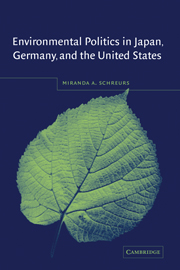Book contents
- Frontmatter
- Contents
- List of figures
- List of tables
- Acknowledgments
- List of abbreviations
- 1 Introduction
- 2 The birth of environmental movements and programs
- 3 The institutionalization of environmental movements
- 4 Acid rain: signs of policy divergence
- 5 Stratospheric ozone depletion
- 6 Global climate change: the road to UNCED
- 7 Global climate change: the battle over Kyoto
- 8 Global environmental politics and environmental policy communities
- 9 Domestic politics and the global environment: Japan, Germany, and the US compared
- Bibliography
- Index
5 - Stratospheric ozone depletion
Published online by Cambridge University Press: 22 September 2009
- Frontmatter
- Contents
- List of figures
- List of tables
- Acknowledgments
- List of abbreviations
- 1 Introduction
- 2 The birth of environmental movements and programs
- 3 The institutionalization of environmental movements
- 4 Acid rain: signs of policy divergence
- 5 Stratospheric ozone depletion
- 6 Global climate change: the road to UNCED
- 7 Global climate change: the battle over Kyoto
- 8 Global environmental politics and environmental policy communities
- 9 Domestic politics and the global environment: Japan, Germany, and the US compared
- Bibliography
- Index
Summary
Damage to the ozone layer was the first truly global atmospheric pollution issue to face countries around the world. The issue had major economic ramifications for Japan, Germany, and especially the US, for they were among the largest producers and consumers of ozone depleting chemicals in the world. The process leading up to the formation of the Montreal Protocol and its subsequent amendments took years. The US, Japan, and Germany differed in their level of interest in, and willingness to act in relation to, stratospheric ozone depletion. These differences stemmed in no small part from the differences in the strength of their environmental policy communities and the core environmental paradigm operating in each.
The formation of the Montreal Protocol was a major success. Subsequent amendments to the Montreal Protocol have essentially called for a complete phase out of ozone depleting chemicals, including five haloginated CFCs that were commercially available (CFC-11, CFC-12, CFC-113, CFC-114, and CFC-115), halons, and methyl bromide. In Japan, CFCs are often referred to as Freon (Flon), a trademark for CFC-12 which is used as a refrigerant. A partially haloginated CFC that has replaced the use of CFCs in some commercial products is hydrochlorfluorocarbon (HCFC)-22. It has a lower ozone depleting potential than the fully haloginated CFCs, but has a high global warming potential.
The formulation of the Montreal Protocol was a remarkable achievement on a number of grounds.
- Type
- Chapter
- Information
- Environmental Politics in Japan, Germany, and the United States , pp. 116 - 143Publisher: Cambridge University PressPrint publication year: 2003

